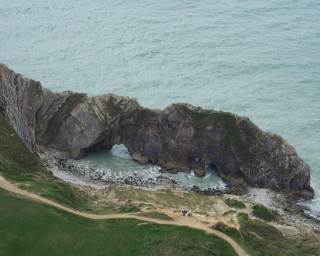|
Stair Hole
Stair Hole is a minor landform to the west of Lulworth Cove. It has formed due to the concordant nature of the coast (geological structure runs parallel to the coast), and shows how coves (shell-shaped bays) are likely to develop in their initial stages. The rock types found in Stair Hole are the Portland Limestone, the Purbeck Beds and the Wealden Clay.
 |
From the seaward side, Stair Hole appears as a series of caves and arches in the resistant Portland Limestone. These have formed as cracks and joints in the limestone have been exploited and widened by marine erosion processes. The Purbeck beds inland from the Portland Limestone are weaker, and are eroded at a faster rate. The "Lulworth Crumple" in the Purbeck Beds can be seen in this photograph. |
 |
When viewed from the landward side, the arches in the Portland Limestone are more visible, and it is clear that this rock type forms a resistant barrier to the sea. Behind this, the Purbeck Beds have been attacked by sub-aerial and marine erosion and the material has been removed by wave action. Since the rate of erosion is more rapid in this rock type, Stair Hole is beginning the process of widening. The cliffs at the rear of Stair Hole are composed of Wealden Clays, and as such are unstable and likely to erode quickly via the processes of sub-aerial erosion and cliff slumping. | |


